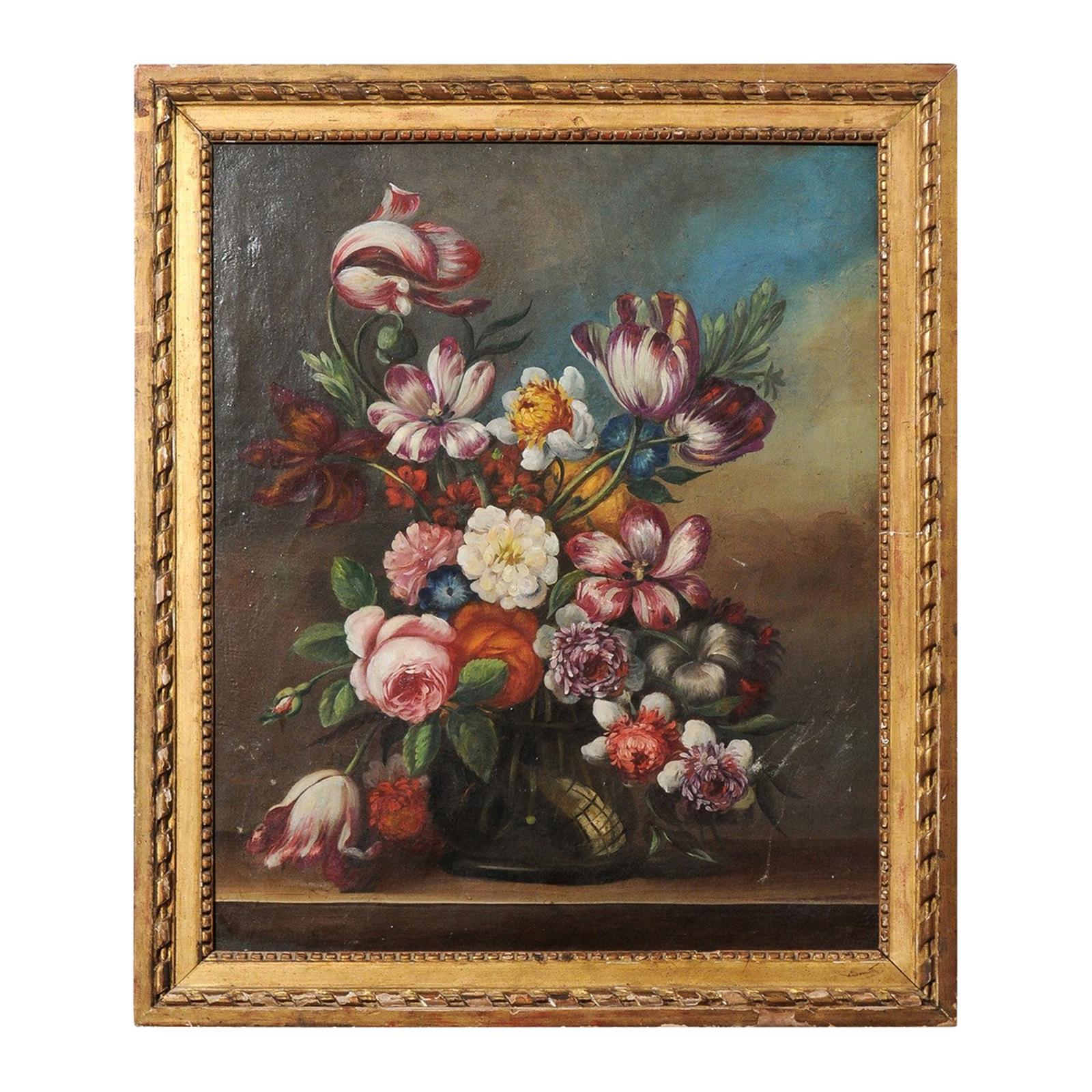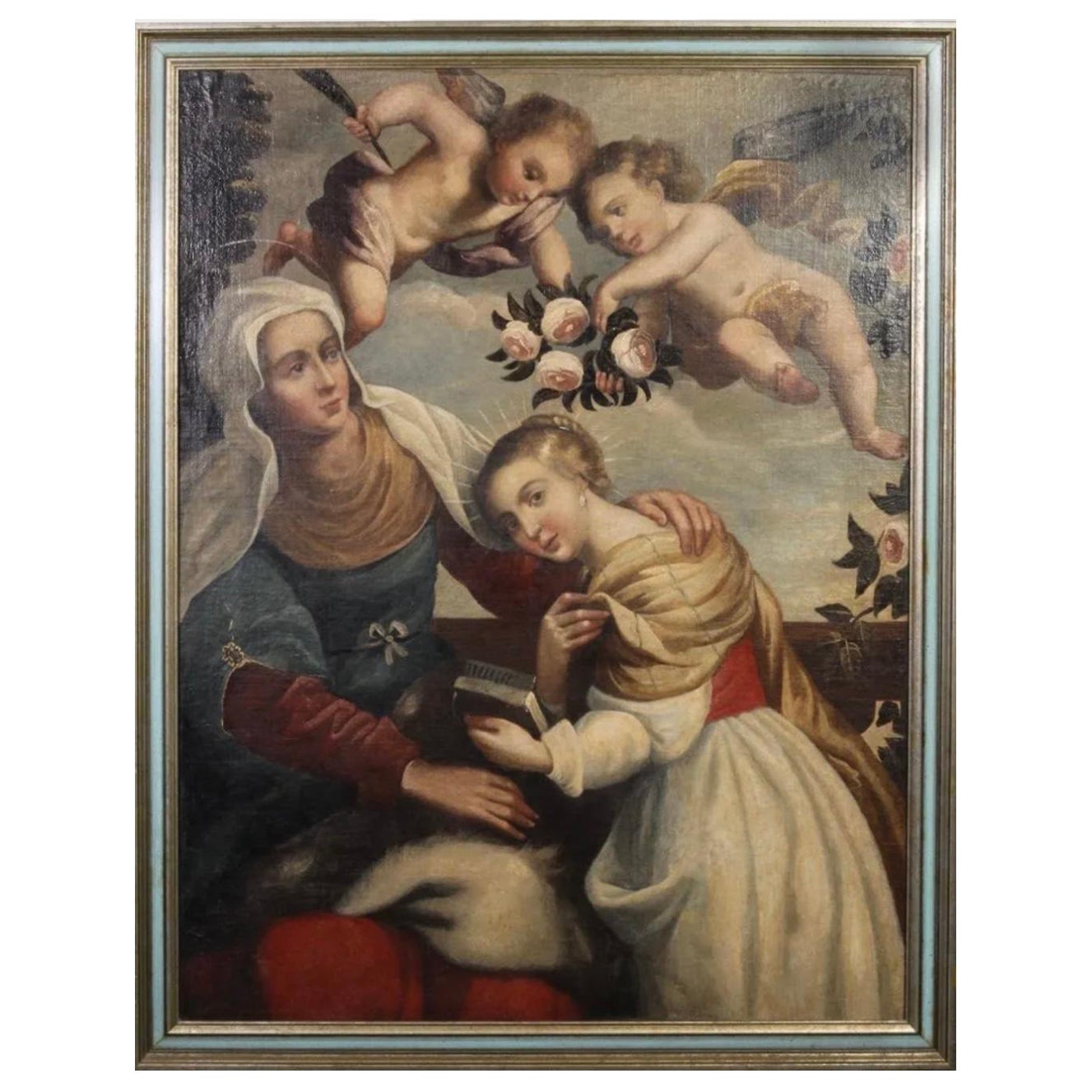Items Similar to Daniel in the lions' den, Italian School, oil on canvas, 18th century
Want more images or videos?
Request additional images or videos from the seller
1 of 13
Daniel in the lions' den, Italian School, oil on canvas, 18th century
About the Item
18th Century Italian School
Daniel in the lion's den
Oil on canvas, 119 x 178 cm
Framed, 125.5 x 185 cm
Signed and dated I.B.P. 1773
A ubiquitous prophet in the Old Testament, Daniel is in selfless and clear spirit a clear prefiguration of Christ. The author even as a child of saving feats, such as his decisive testimony at the court during the well-known episode of Susanna and the old men, Daniel is most remembered today for the episode recounted in the biblical book of the same name (Dan. 6). Darius king had reorganized his kingdom into provinces, at the head of which he placed as many as one hundred and twenty sàtraps; these were in turn subject to the orders of three officials, among whom was Daniel, deeply respected by Darius for his noble spirit. The satraps entered into cahoots with Daniel, envious of his power. They therefore tricked Darius into signing a document that would prosecute anyone who did not pay homage as king and god to Darius alone. The satraps knew Daniel's faith, and they arrested him and brought him before Darius. The latter, much grieved, was forced to comply with what he had previously signed. Daniel was thrown into the lions' den, where all those guilty in regard to the administration of the state found their place; the den was closed from above with a stone, and Daniel left to his fate. As is well known, the lions did not touch him: the prophet asserted it was an angel that clamped its ravenous jaws. In Dan. 14:33-39 the story is deepened: one day God commanded another prophet, Habakkuk, to join Daniel in the pit to feed him. But Habakkuk knew neither Babylon nor the pit: the angel of the Lord therefore seized him by the hair and carried him by flight to Babylon. Arriving in the vicinity of the pit, in this version not enclosed by boulders, Habakkuk handed Daniel the bread he had brought with him. Daniel thus knew that God had not forsaken him and ate, confident of his own salvation. Darius, having discovered his protégé still alive, felt extreme happiness in his chest.
- Dimensions:Height: 46.86 in (119 cm)Width: 70.08 in (178 cm)Depth: 1.58 in (4 cm)
- Materials and Techniques:Canvas,Oiled
- Period:
- Date of Manufacture:unfamiliar
- Condition:
- Seller Location:Milan, IT
- Reference Number:1stDibs: LU5918239024822

About the Seller
5.0
Vetted Seller
These experienced sellers undergo a comprehensive evaluation by our team of in-house experts.
Established in 2000
1stDibs seller since 2021
25 sales on 1stDibs
Typical response time: 12 hours
- ShippingRetrieving quote...Ships From: Milan, Italy
- Return PolicyA return for this item may be initiated within 14 days of delivery.
More From This SellerView All
- 18th Century The Sacrifice of Iphigenia Roma School Painting Oil on CanvasLocated in Milan, ITRoman school, 18th century The Sacrifice of Iphigenia Oil on canvas, Measures: 50 x 64.5 cm The canvas depicts The Sacrifice of Iphigenia, a theme reported by numerous sources, including the Greek tragedies Iphigenia in Aulis by Euripides and Agamemnon by Aeschylus, as well as in Ovid's Metamorphoses. The myth tells how the Greeks, under the command of Agamemnon, gathered at the city of Aulis, in Boeotia, from which they then set sail for Troy. The persistent calm of the winds, however, prevents the Greek ships...Category
Antique 18th Century Italian Paintings
MaterialsCanvas
- 18th Century Concert scene Painting Oil on Canvas by Daniel Nikolaus ChodowieckiLocated in Milan, ITDaniel Nikolaus Chodowiecki (Danzig, 1726 - Berlin, 1801) Interior scene with concert Oil on canvas, 42 X 34 cm With frame 57 x 49 x 6 cm Already attributed to Pietro Longhi, the ...Category
Antique Mid-18th Century German Paintings
MaterialsCanvas
- 18th Century Scene with Spinner Piedmontese school Painting Oil on CanvasLocated in Milan, IT18th century, Piedmontese, School Scene with spinner Measures: Oil on canvas, 50 x 60 cm Frame 70 x 80 cm.Category
Antique 18th Century Italian Paintings
MaterialsCanvas
- 18th Century St. Francis Receives the Stigmata Painting Oil on CanvasLocated in Milan, ITXVIII century St. Francis receives the stigmata Oil on canvas, 97 x 75.5 cm.Category
Antique 18th Century Italian Paintings
MaterialsCanvas
- 17th Century Christ and the Samaritan Oil on Canvas Roman SchoolLocated in Milan, ITRoman school of the 17th century Landscape with bridge - Christ and the Samaritan woman at the well Oil on canvas, cm 42 x 59,5 - With frame, cm 54, 5 x 71 cm The small canvas portrays a broad view of the city surrounded by a bucolic and lush landscape, probably a reinterpretation of the Roman countryside or the Agro. The fulcrum of the canvas is the bridge consisting of several bays beyond which stands a village. In the distance the landscape made of green mountains opens into what looks like a lake crossed by boats. The landscape is animated by the human presence; not only small and fleeting figurines intent on walking along earthy paths but also the representation, in the foreground, of an Gospel episode, that of Christ and the Samaritan woman at the well. The landscape can be clearly traced back to a painter trained on the examples of the great seventeenth-century Roman baroque landscape that sees in the Lunette Aldobrandini by Annibale Carracci but also in Claude Lorrain, Nicolas Poussin and Gaspar Doghet are its greatest achievers. If in the past, therefore, the landscape was considered the scenic background on which to project the representation of divine or human characters, in the seventeenth century it became an autonomous and codified pictorial genre. With Carracci comes the so-called ideal landscape: a mental reconstruction of a peaceful and harmonious nature in which the dream of a perfect communion with man is realized. In the wake of Hannibal, as mentioned, during the seventeenth century the "classic" Roman landscape knows a long and happy season by artists such as Domenichino, and the French Claude Lorrain, Nicolas Poussin and Gaspar Dughet. Lorrain investigates the Roman countryside in all its aspects, studying the variations in the different hours of the day, the seasons or weather conditions, but always nourished by a sense of bucolic Virgilian. With Poussin the approach becomes intellectual elaboration and sophisticated rational construction. From the examples of the great masters, the Roman Baroque season, from the middle of the century, saw the flourishing of several personalities who, with shots, but also important personal reworkings, led to further spread the genre. Among the personalities that can be compared to the work in question we cannot fail to mention Crescenzio Onofri (1634-1714), defined by Salerno as the only true pupil of Dughet, who then spread in Florence the taste of the Baroque landscape influencing Tuscan painters such as Panfi and Peruzzini. His paintings are in various Roman collections; such as, for example, the landscapes from the Sacchetti Collection and today at the Pinacoteca Capitolina. and those in the Almagià collection in Rome, others in the Palazzo di Montecitorio, but the most conspicuous group is in the Galleria Doria. In comparison we can mention the two passages of the National Gallery in London, the landscape with a bridge over the Antiquarian Market but also the design of the National Gallery of Art in Washington. In the work you can also find the influences of the art of Giovanni Francesco Grimaldi...Category
Antique 17th Century Italian Paintings
MaterialsCanvas
- 18th Century Cherub Head Sketch Painting Oil on CanvasLocated in Milan, ITVenetian school, 18th century Study with the head of a cherub Measures: Oil on canvas, 45.5 x 41 cm - with frame 54.5 x 49.5 cm The present qualifies as a study or preparatory sketch by virtue of the structural and figural layout; by reason of formal and substantial evidence, it can be traced back to the mature neo-Venetian style, which in the eighteenth century had begun to produce figurations of extreme typological pathetism and formal expressionism. The contemporary painting experience of Tiepolo commanded the Venetian art scene, once the lesson of Pier Francesco Mola (1612-1666) was overruled. The delicate putto head offered here, in which a cherub is recognizable due to the happy iconographic solution of the wings placed under the angel's face, is outlined with a vigorous vitalism. A foreshortened point of view illuminates his face in a grazing way, probing his features with strong shadows and with a youthful blush that orange his cheeks. The veristic perfection with which the artist arranges the semblant is of marvelous expressiveness. The eyes are swollen with intensity, and together with the general setting of the head they denounce a conscious reflection on the physiognomy, peculiar within the emerging context of Venetian painting. The painting in question is affected by the large-scale productions, both monumental and perspective, at the time in vogue in the territory of the Serenissima. Conceived through a vision from below, the portrait reveals from the Venetian Rococo that particular predilection for the open and clear, airy ways, denounced in the first instance by Tiepolo. The conscious detachment from the Cortona-style decorativism and from the repeated layout solutions then in vogue allow us to approach the present to the production of Francesco Fontebasso...Category
Antique 18th Century Italian Rococo Paintings
MaterialsCanvas
You May Also Like
- 18th Century Oil on Canvas Italian SchoolBy Carlo MarattaLocated in Marseille, FRPainting with probably biblical Italian school characters End of the 17th beginning of the 18th century unsigned carrying a Carlo Maratta cartouche of in...Category
Antique Early 18th Century Italian Baroque Paintings
MaterialsCanvas
- "Piety". Oil on Board. Italian School, 18th CenturyLocated in Madrid, ESThe work presented here is a devotional painting, especially for its small format, probably intended for a private altar. It represents with a scenographic sense and deep dramatism t...Category
Antique 18th Century European Neoclassical Paintings
MaterialsWood
- French 18th Century Oil on Canvas Floral Painting in the Dutch School StyleLocated in Atlanta, GAA French oil on canvas still-life floral painting in the Dutch School style from the 18th century, in giltwood frame. Born in France during the Age of Enlightenment, this exquisite floral painting presents a strong influence from the Dutch School. Capturing our attention with its bright colors and skillfully depicted presence, a luscious bouquet of flowers displayed on a tabletop, stands out beautifully on a neutral blue and golden background. Pink, white, orange, green, blue and red tones among others are playing with one another in a subtle dance that leaves us mesmerized. Set inside a giltwood frame accented with twisted ribbons and petite beads, this 18th century French floral oil...Category
Antique 18th Century French Paintings
MaterialsCanvas, Giltwood, Paint
- Spanish Colonial 18th Century Cuzco School Oil on CanvasLocated in Bradenton, FLA traditional and characteristic 18th century, Spanish colonial oil on canvas painting depicting the Virgin Mary holding a book with St. Anne an...Category
Antique 18th Century Peruvian Spanish Colonial Paintings
MaterialsCanvas, Paint
- "Galant Scene" Oil on Canvas, French School, 18th CenturyBy Europa AntiquesLocated in Madrid, ESGALANT SCENE Oil on canvas, French school, 18th century. Dim.: 64 x 115 cm. good conditions.Category
Antique Early 18th Century French Baroque Paintings
MaterialsPaint
- Antique 18th Century Madonna in Sorrow Oil on Canvas, Florentine SchoolLocated in Doha, QAThis antique stunning portrait of Madonna in Sorrow came out from a Palazzo in Florence and an absolute eye catcher. The colors and details are incredible and very typical for an Ita...Category
Antique Late 18th Century Italian Baroque Paintings
MaterialsCanvas





